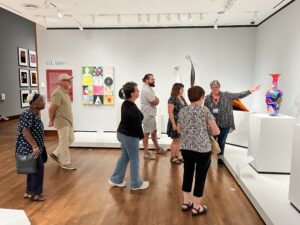What’s a Sunday tour at the Chazen Museum of Art like?
It might be a tour of a single exhibition. It might focus on a theme. Whatever the content, it will encourage you to look deeply, ponder, and react.
Museum Guide Ann Schaffer says the Chazen has moved away from trying to cover the entire museum in a single tour in favor of a more flexible approach, where guides choose a handful of objects to spark discussion.
“A highlights tour suggests an objective ranking of artwork, which really isn’t possible,” she said. “Our current tour style is about connecting the visitor with the art through conversation and activities. We think they’ll remember that relationship more than they would a lecture.”
Shaffer led a recent Sunday tour that put these ideas into practice. On the tour were Cynthia May; her sister Jill Amel and Jill’s husband, Gary Amel; Jacqueline Dupiche; and Nemo and Stephani Gehred-O’Connell.
The group first looked at Petah Coyne: How Much A Heart Can Hold, stopping at Untitled #1378 (Zelda Fitzgerald.) “I’m going to invite you first to just walk around and look at it from different angles,” she said.
“Really beautiful.”
“Wow.”
“Must have taken a long time.”
“She did not do this overnight,” Schaffer said. (Coyne worked on the sculpture from 1997 through 2013.)
Tour members discussed Zelda Fitzgerald’s history as a troubled, dynamic, artistic woman obscured by the shadow of her more famous husband, the writer F. Scott Fitzgerald.
“So, what do you notice?” Schaffer said.
“The first thing that comes to mind is a candelabra,” said May.
“What else?”
“A birthday cake,” said Gary Amel.
“What did she use to make this?”
“This is made from a variety of materials, beads, silk flowers, porcelain hands, and she uses a special wax,” Schaffer said. “Her work is characterized by layers and layers and layers. There are things hidden inside of this piece that she has covered over that she doesn’t even remember what’s in there.”
“The woman’s face over here, is that of any particular significance?” Gary Amel asked.
“Is it her?” May asked.
“It could be,” Schaffer replied. “It could be.”
“Or representing all women,” May said.
Schaffer pointed out that the special glass encasing Zelda is not just a museum display case but an essential part of the work itself. From some angles it’s almost invisible and from others, it causes layered reflections, complicating a direct view of the subject.
“Oh wow!”
“That’s amazing, I didn’t notice that.”
As they passed through the rest of the exhibition, visitors marveled at Coyne’s rich, mysterious works, lingering a bit at Untitled #720 (Eguchi’s Ghost): a floating, swirled mass of hair-like, shredded metal and a dark empty face.

Chazen tour guide Ann Schaffer (right) discusses Shard Whopper with tour members (from left) Jacqueline Dupiche, Gary Amel, Jill Amel, Nemo Gehred-O’Connell, Stephani Gehred-O’Connell, and Cynthia May.
Next, the group visited a nearby exhibition, Look What Harvey Did: Harvey K. Littleton’s Legacy in the Simona and Jerome Chazen Collection of Studio Glass . Schaffer sketched out Littleton’s importance in launching the international studio glass movement here at UW–Madison. Then she stopped at Clifford Rainey’s War Boy, a translucent, etched-glass torso with rifle cartridges spilling out through large splits held together with copper wire. “What do you notice about this piece?”
“It’s weird,” said Jill Amel.
“How is it weird?” Schaffer asked.
“It’s scary, the skin and the hair. Sewing the flesh together.”
“This artist used a cast-glass technique, and he used the body of his grandson, his ten-year-old grandson, to cast this,” Schaffer said. “And if you can imagine it without the wrapping, without the bullets, how beautiful that piece would be. And evocative of antiquity, with the torso and arms broken off.”
The last stop was Nordic Utopia? African Americans in the 20th Century, where the group studied six paintings by William Henry Johnson. “I want you to look at these six for a few minutes and then decide which is your favorite,” Schaffer said.
“Some of these are pretty simple, like this one (Girl in a Red Dress), and some are pretty complicated, like this one (A View Down Akersgate, Oslo). That’s what I took away,” Gary Amel said.
“What else?”
“Fluid versus stable,” said Jill Amel.
“Yes, the portraits are very solid,” Schaffer said. “And the landscapes are pretty dynamic, with lines, movement, brushwork.”
Nemo Gehred-O’Connell said that the landscapes were painted earlier in the day and the portraits later.
“After coffee,” Gary Amel added, to chuckles.
Boats in the Harbor, Kerteminde, was the favorite of Stephani Gehred-O’Connell and Gary Amel. “I just like the colors of it, and the movement and kind of the way it’s a feeling of boats, instead of just being solid boats,” Gehred-O’Connell said.
“I like the Danish Seaman, because that piece seems simpler to me,” said Dupiche.
“I think he’s a real character,” May said. “Very sure of himself.” After having chosen Akersgate previously, May said she was switching her vote to Seaman.
“Why is that?” Schaffer asked.
“I just think, wow, he really caught the essence of the guy’s character,” May said. “But I really like the landscapes too.”
As the tour wrapped up, members thanked Schaffer, who encouraged them to come back. “It’s your museum,” she said. “I hope you take some of this home with you today. It’ll be in your dreams, it’ll be in your daily life.”
“Like that hair monster (Coyne’s Eguchi’s Ghost) downstairs,” Nemo Gehred-O’Connell quipped.
So, what did tour members think?
“I really like hearing other people’s impressions of what you’re seeing,” May said.
“It’s nice to have a group this small,” Gary Amel said. “You can actually share ideas. You generally don’t even ask if you’re in a big group.”
“That’s the idea,” Schaffer said. “I’d like for you to establish a relationship with the pieces. And I think we can’t do that if we’re just touring around. You see it, but it doesn’t come inside.”